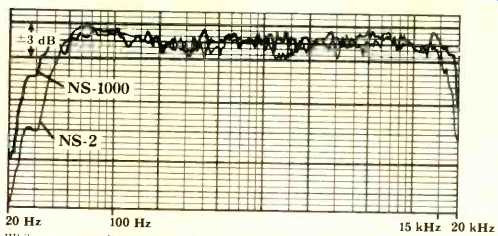PART TWO: THE END OF THE DOUBLE STANDARD.
In the frequency range where you find most music, our least expensive speaker offers virtually the same flat frequency response and freedom from distortion as our most expensive speaker.
Until recently, you could consider the selection of speakers an act of faith.
Because of the lack of industry standards and the resulting confusion in the marketplace, the speaker buyer had to depend almost totally on personal taste and subjective evaluation.
But no longer.
At Yamaha, before we designed a new line of speakers that would equal the revolutionary standard of our electronic components, we first defined our goal:
High accuracy across the musical spectrum. One of the few objective criteria for rating speaker performance.
Then we proceeded to make all Yamaha speakers to a single revolutionary standard of accuracy:
A frequency response curve that varies by no more than ±3dB from 100 Hz to 15,000 Hz.
With typically no more than 1% harmonic distortion.
But since the frequency range of all our speakers ex tends well below 60 Hz to beyond 15,000 Hz, why do we even bother mentioning this figure? Because, with the exception of the very deepest rumblings of a pipe organ, all music is produced within this range.
In fact, few if any commercially available stereo pressings have frequencies below 100 Hz and above 15,000 Hz.
Yamaha's success in achieving a single standard of accuracy in all our speakers is confirmed in the chart above.
Unlike the frequency response curves of other speaker manufacturers which indicate unnatural booming in the bass, added sparkle in the treble, and extreme loudness level variations of as much as 10 dB, Yamaha's frequency response curves show a relatively straight line, which indicates uncolored, natural sound.

-------- While many manufacturers offer accurate reproduction only in
their top-end speakers. Yamaha brings you an extremely high degree of accuracy
in all models throughout the line. The above curves, comparing the NS-1000 with
the NS-2, were recorded under the following conditions:
1. Equipment used--Bruell & Kjaer [B&K] 4133 microphone, 1022 oscillator. 2113 spectrometer, and 2305 recorder. 2. Input-A "pink" noise source was used with an input level of 3 watts (significantly higher, more rigorous, and more closely corresponding to actual home listening levels than the commonly used industry standard of 1 watt). 3. Measurement-- Each loudspeaker was placed in a "free field” [off the floor and no closer than 5 feet to any wall boundary in an average size listening rooms.] A multiplicity of curves were taken at various points in the listening room and averaged, to produce the total energy curves pictured.
--------------
Yamaha's musical heritage.
Yet, in spite of Yamaha's objectivity in design, the perception of sound remains subjective.
That's why Yamaha speakers aren't designed to meet objective standards alone, but to meet a higher standard: the ears of the people who make Yamaha's world-famous musical instruments.
Since 1887, Yamaha has been making some of the finest musical instruments in the world.
Pianos, organs, woodwinds, guitars, and brass.
With our musical instruments, we've defined the standard in the production of fine sound. And now, with our entire line of speakers and electronic components, we've utilized not only our studio engineers, but also our musical instrument designers to de fine the standard of music reproduction.
It's called Natural Sound. And it's totally unique to Yamaha.
Five different speakers, built to one standard.
Yamaha offers five different speaker models, ranging in price from $1,350 a pair down to $200 a pair.
At the top, the revolutionary beryllium dome NS-1000 Series, offering the ultimate in state-of-the-art performance.
Following the NS-1000 are our other three-way types: the NS-690, NS-670, and NS-3. Our least expensive, but still highly accurate, is the two-way NS-2.
Since each is built to the same high quality standard, you're probably wondering what those extra dollars are buying.
It's very simple.
To satisfy the most demanding audiophiles, those extra dollars buy extended response at the frequency extremes.
Higher sound levels with equal or lower distortion. More power handling capacity. More tone controls to contour the tonal balance of the speakers with the characteristics of the room.
More specifically, on our model NS-670 and above, Yamaha offers die-cast speaker frame baskets to eliminate potential resonance. Luxurious wood enclosures (even rare ebony wood!). Tangential –edge suspension for midrange and tweeter domes to provide smooth response. Acoustic equalizers on tweeters to flat ten frequency response and enhance dispersion. Diagonally edge-wound voice coils for greater diaphragm control and increased transient response. Plus thick felt lining inside the cabinetry to isolate rear sound waves for distortion-free bass response.
But regardless of how much you pay, every Yamaha speaker is built to the same essential construction criteria and tonal accuracy.
Proven acoustic suspension design. Dome drivers for better high frequency dispersion.
Carefully matched crossover networks. And heavily reinforced, extremely rigid en closures.
The End of the Double Standard.
The single standard of performance found throughout the entire line of Yamaha speakers is a demonstration of product integrity that no other manufacturer can claim.
But in the final analysis, only your ears can be the judge.
That's why we invite you to visit your Yamaha audio dealer soon. His knowledgeable sales men and extensive demonstration facilities can save you time and trouble in selecting the speaker that's right for your budget. And right for your ears.

YAMAHA International Corp., P.O. Box 6600, Buena Park, Calif. 90620
= = = =
Like Yamaha? Have a look at: